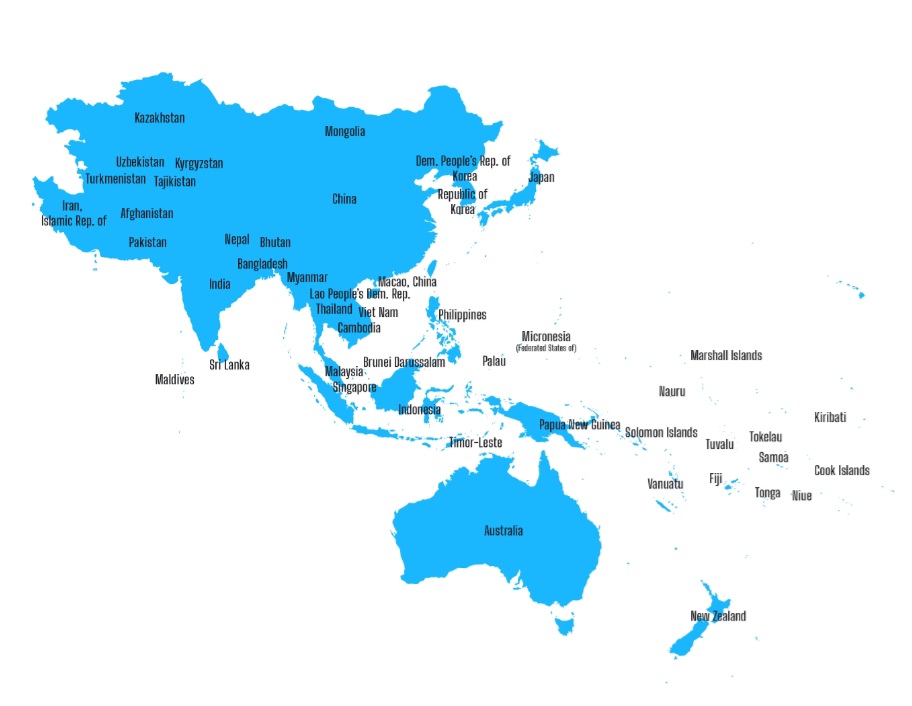By: Sagnik Sarkar

Introduction
Over the span of the 21st century, global militarization has accelerated, with a clear recalibration towards the Asia Pacific. Military expenditure rose from $1.12 trillion (in 2020 dollars) per year to $2.11 trillion between 2000 and 2021. Data compiled by the Stockholm International Peace Research Institute show that during that period, Asia and Oceania’s share of global defense spending rose from 18% to 28%. An arms race across the region has been sparked by growing worries about China, whose defense expenditure has been rising steadily for almost three decades, upending decades-old regional conventions and exposing several potential flashpoints.
The Chinese Quest for Taiwan
How China’s military buildup fits into its plans to annex Taiwan is the greatest worry. The possibility of a Chinese invasion of Taiwan is higher than it has been in years, but estimates of when it might occur differ. Senior US military figures have recently given alarmingly close deadlines, such as 2023, 2025, and 2027. However, some analysts warn that these military figures are probably exaggerating to advocate for more funding. American evaluations are important because it’s possible that the US military will assist in defending Taiwan against Chinese attacks. According to sources, the president of Taiwan is frustrated by the public forecasts because she wants to make sure that people are concerned about the China threat just enough to support her policies but not too much that they give up hope.
China will raise its defense spending by 7.2% in 2023, making it the highest level ever, despite still allocating a smaller percentage of its GDP to defense than the US. According to the US Department of Defense, China’s actual military spending may be up to twice as much as what is publicly disclosed. In reaction, increasing the military presence in the Indo-Pacific has been given priority in the most recent US budget’s defense section. The US also gave its approval this month for Taiwan to possibly purchase new weaponry worth $619 million. The impact on the regional military power balance is just as significant as the higher spending. China was the Indo-Pacific region’s second-largest spender on military in 2000. By 2021, it spent more on defense than the following 13 nations in the area put together.
Additionally, a trilateral deal involving Australia, the US, and the UK has drawn strong criticism from China. The US and UK will assist Australia in acquiring at least three nuclear-powered submarines over the following three decades as part of the AU$368 billion Aukus agreement. Multiple opinions have been expressed regarding Aukus, which is generally believed to be intended to counter China’s military buildup. The allies, according to China, were “walking further and further down the path of error and danger” by lying, abusing non-proliferation treaty provisions, and using loopholes.
The Scramble in the South China Sea
One of the world’s most vital waters in terms of both strategy and commerce is the South China Sea. One of the busiest trade routes in the world, it is abundant in marine life and is believed to hold sizable reserves of natural gas and oil. Hence, it is hotly disputed.
China claims almost the entire South China Sea, with its infamous “nine-dash” line serving as the country’s legal border. However, this claim has been denied by an international tribunal in The Hague. There are conflicting claims from the Philippines, Vietnam, Malaysia, Brunei, and Taiwan. Despite not being a candidate, the US views the water as being essential to its national interests.
The Philippines has adopted a much tougher stance on the conflict under President Ferdinand Marcos, accusing Chinese ships of “aggressive actions” in the South China Sea. The Philippines opened up more of its military bases to the US in March, strengthening Washington’s position there and making it easier for it to keep an eye on Chinese action in the South China Sea near Taiwan. Additionally, it has improved military relations with two US allies, Japan and Australia, and simultaneously also backed the development of the AUKUS, in contrast to neighboring Southeast Asian nations, some of whom fear that it could spark an arms race that destabilizes the area.
The Pacific Power Circus
Pacific leaders have resisted taking a position in the geostrategic conflict between the US and China and have repeatedly emphasized that they don’t want to be drawn into it. Additionally, they frequently assert that the climate catastrophe is their biggest security threat.
China, however, has stepped up its efforts to gain sway among the Pacific Island nations, particularly in matters of law enforcement and security. The US, New Zealand, and Australia have all moved to step up their diplomacy efforts in response to these efforts, which have caused something of a reckoning.
The signing of a security deal with the Solomon Islands almost a year ago serves as the clearest example of Beijing’s advancement in the area. According to a draft that was leaked, the agreement would enable China to carry out a variety of requests from the police and armed forces, including upholding societal order and defending “the safety of Chinese personnel and major projects in the Solomon Islands.”
Even though the prime minister of the Solomon Islands, Manasseh Sogavare, has repeatedly reassured Australia and other countries that there will never be a foreign military base in his country, Australian officials had privately expressed concerns that the deal might open the door for a future Chinese naval presence about 1,700 kilometers from the country’s coast.
The Pacific leaders rejected China’s request for a broad regional security agreement with 10 Pacific nations last year because they believed Beijing was attempting to sidestep established institutions like the Pacific Islands Forum. (PIF).
China’s diplomacy efforts have prompted a rush of responses from other nations. The Australian Labor government has made reestablishing trust with Pacific leaders a top goal since taking office last year. In a succession of high-level visits, the foreign affairs minister Penny Wong and others have emphasized that the immediate region should be in charge of security. After signing a contract with Vanuatu in December, Australia hopes to complete talks on a bilateral security arrangement with Papua New Guinea by the end of April.
The US reopened its embassy in the Solomon Islands in February after admitting it needed to do more in the area, but western authorities are aware of the trends. The Australian government believes that despite initial relief at the decision by Pacific island nations to postpone China’s expansive security plans, this may only be a brief reprieve. Last year, a high-ranking government official acknowledged that “things aren’t going back to the way they were.”
Ambitious or Insecure: The Record-Breaking North Korea
North Korea looks focused on breaking its own record this year after launching roughly 90 ballistic missiles and other weapons in 2022. In total, it has tested 11 different types of missiles so far in 2023, some of which involved more than one weapon. These tests involved two intercontinental ballistic missiles and, according to state media, strategic cruise missiles with a nuclear capacity.
The Pyongyang regime recently unveiled new, smaller nuclear warheads and vowed to create more weapons-grade nuclear material, showing that it has no plans to give up its arsenal of weapons of mass destruction. An “exponential increase” in the regime’s nuclear stockpile was demanded by Kim Jong-un at the close of the previous year.
The US and South Korea are the principal targets of the North’s provocations. Days after concluding their largest combined military exercises in five years, forces from both nations participated in joint maritime exercises that included the nuclear-powered aircraft carrier USS Nimitz. The exercises, which the allies insist are solely defensive in nature, are denounced by Pyongyang as a practice for an invasion.
Yoon Suk Yeol, the conservative president of South Korea, has responded harshly to the escalating hostilities on the Korean peninsula by announcing that Seoul will not give the North a “single penny” as long as it continues to work on nuclear weapons. A serious debate over whether Seoul should acquire its own nuclear deterrent is currently taking place, which is concerning for those hoping to reduce tensions. Polls show that the majority of South Koreans back this course of action.
Japan’s argument for moving further away from its wartime “pacifism” has been strengthened by worries about North Korea and a more assertive China. Japan’s government, led by Prime Minister Fumio Kishida, declared late last year that it would abandon its self-imposed cap of 1% of GDP and double defense spending to 2% of GDP by 2027.
A long-awaited warming of ties between Japan and South Korea, both US allies with tens of thousands of American troops stationed there, has been sparked by the region’s increasingly unstable security environment. Yoon and Kishida held their first bilateral discussions between the leaders of South Korea and Japan in 12 years in March. After a five-year hiatus, their summit in Tokyo produced an agreement to restart reciprocal visits and a security dialogue as they worked to settle differences stemming from their bitter wartime past.
Conclusion
The instances mentioned above are a clear portrayal of the Asia-Pacific region being the new ‘hotbed’ of a global arms race. And with the changing dynamics of the global order and the involved power equations, this phenomenon is going to be a common sight in the near and distant future. With the rise of China as a significant power (or even a ‘superpower’ in the making) which can surely cause major alterations to the world order in existence, the Asia-Pacific region has now gained significant traction as the main ‘battlefield’ of the new power struggle. Instances of this ‘arms race’ progressing even further in this region, hence, may also be a reality, with the passage of time.

About the Author
Sagnik Sarkar is a graduate of Political Science from the Department of International Relations, Jadavpur University. Currently, he is pursuing his Masters in International Relations from the same institution. He is passionate about researching, and has a special interest towards International Relations, Diplomacy, Connectivity, Trade, Human Rights, Conflict Studies, Public Policy and Governance. He has been associated with numerous think tanks in the past, such as CSIRD, Asian Confluence and Asia in Global Affairs. He is extremely enthusiastic about academic writing and has authored and published numerous research papers and articles pertaining to various issues under the realm of Political Science and International Relations for notable organizations. The views expressed are personal.

